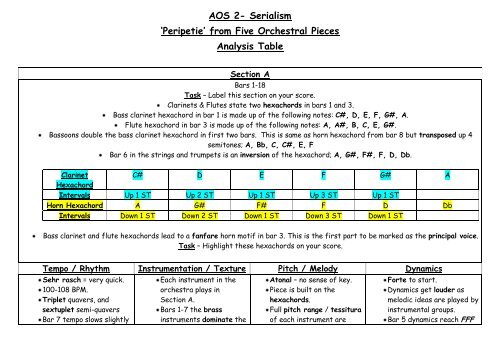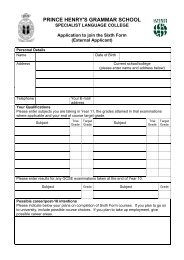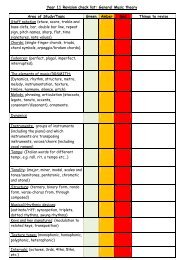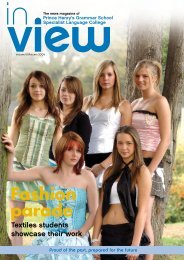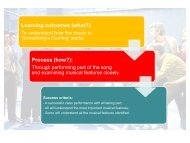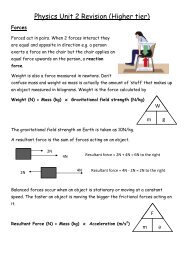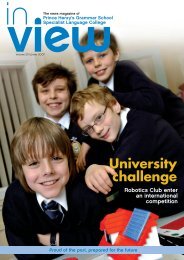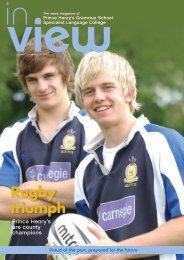AOS 2- Serialism 'Peripetie' from Five Orchestral Pieces Analysis ...
AOS 2- Serialism 'Peripetie' from Five Orchestral Pieces Analysis ...
AOS 2- Serialism 'Peripetie' from Five Orchestral Pieces Analysis ...
- No tags were found...
Create successful ePaper yourself
Turn your PDF publications into a flip-book with our unique Google optimized e-Paper software.
<strong>AOS</strong> 2- <strong>Serialism</strong>‘Peripetie’ <strong>from</strong> <strong>Five</strong> <strong>Orchestral</strong> <strong>Pieces</strong><strong>Analysis</strong> TableSection ABars 1-18Task – Label this section on your score.Clarinets & Flutes state two hexachords in bars 1 and 3.Bass clarinet hexachord in bar 1 is made up of the following notes: C#, D, E, F, G#, A.Flute hexachord in bar 3 is made up of the following notes: A, A#, B, C, E, G#.Bassoons double the bass clarinet hexachord in first two bars. This is same as horn hexachord <strong>from</strong> bar 8 but transposed up 4semitones; A, Bb, C, C#, E, FBar 6 in the strings and trumpets is an inversion of the hexachord; A, G#, F#, F, D, Db.ClarinetC# D E F G# AHexachordIntervals Up 1 ST Up 2 ST Up 1 ST Up 3 ST Up 1 STHorn Hexachord A G# F# F D DbIntervals Down 1 ST Down 2 ST Down 1 ST Down 3 ST Down 1 STBass clarinet and flute hexachords lead to a fanfare horn motif in bar 3. This is the first part to be marked as the principal voice.Task – Highlight these hexachords on your score.Tempo / Rhythm Instrumentation / Texture Pitch / Melody DynamicsSehr rasch = very quick.100-108 BPM.Triplet quavers, andsextuplet semi-quaversBar 7 tempo slows slightlyEach instrument in theorchestra plays inSection A.Bars 1-7 the brassinstruments dominate theAtonal – no sense of key.Piece is built on thehexachords.Full pitch range / tessituraof each instrument areForte to start.Dynamics get louder asmelodic ideas are played byinstrumental groups.Bar 5 dynamics reach FFF
(etwas ruhiger).Rubato clarinet melody atbar 10 makes tempo feelslower than it actually is.texture.Trombones take over theprincipal voice in bars 5-6 before it returns tothe horns.Bars 8-10 ostinato inbassoons and bassclarinet.Bar 10-18 soft clarinetmelody. Marked asprincipal voice.Instrumental groups playin quick succession withsome overlaps of chordal/ homophonic bursts.Texture thins <strong>from</strong> bar10 as clarinet melody isplayed.used.Bar 10 – clarinet melody isexpressive, gentle, angularand uses dissonant leaps ofminor 9 th , major 7 th anddiminished octave. Thesecause dissonance andcreate tension.before dying away to PP.Brass instruments use amute. Schoenberg usesthis for the dampenedsound quality while stillusing extremes of ranges,which is unusual.
Section BBars 18-34Task – Label this section on your scoreBar 18 cello takes over the role of principal voice <strong>from</strong> clarinet.Bar 20 trumpet takes over role of principal voice <strong>from</strong> cello.From bar 20 to bar 34 the principal voice passes between 7 different instruments.Bar 28 trumpet one enters with secondary voice.Bar 29 piccolo, flute and clarinet in D join in as secondary voices.Cello plays in a very high tessitura in what develops into a frantic section.Task – Highlight the principal and secondary voice sections.Tempo / Rhythm Instrumentation / Texture Pitch / Melody DynamicsTempo returns to originalmarking of sehr rasch.Short note durations suchas quavers and semiquavers make the musicseem faster than itactually is.Full orchestra is used inSection B.Orchestra is used indifferent instrumentalcombinations until bar 30where the full orchestraplay together.Bars 30-34 are theclimax of this section.Not all instruments playfor the full 5 bars. Windand percussioninstruments provide theinstrumental power.In bars 32-34 violin 1and cello have a soft andgentle melody line. It isAtonal – no sense of key.Piece is built on thehexachords.Full pitch range / tessituraof each instrument areused.Bar 10 – clarinet melody isexpressive, gentle, angularand uses dissonant leaps ofminor 9 th , major 7 th anddiminished octave. Thesecause dissonance andcreate tension.Forte to start.Dynamics get louder asmelodic ideas are played byinstrumental groups.Bar 5 dynamics reach FFFbefore dying away to PP.Brass instruments use amute. Schoenberg usesthis for the dampenedsound quality while stillusing extremes of ranges,which is unusual.
very difficult to hear butadds to the texture anddemonstratesSchoenberg’s attention todetail.Texture is complex andpolyphonic.Section A’Bars 34-43Task – Label this section on your scoreSection A’ starts with the return of the violins as the principal voice with an ascending melody.A flourish <strong>from</strong> the horns answers the violins in bar 37 this then leads us to bar 40 and a return of the horn hexachord <strong>from</strong>bar 8.This section provides us with a rest <strong>from</strong> the turmoil of section B.Mood is menacing giving the impression that there is more turmoil and fireworks to come in the following sections.Task – Highlight the principal voice sections.
Section CBars 18-34Task – Label this section on your score.Bar 44 bassoon is principal voice.Bar 45 takes cello over the principal voice role.Task – Highlight the principal voice sections.Tempo / Rhythm Instrumentation / Texture Pitch / Melody DynamicsTempo marking alternatesbetween ruhiger whichmeans calmer and heftigwhich means passionate.Bars 44-52 are made upof a sparse texture.In these barsSchoenberg continues tooverlap solos in differentinstruments.Bars 53-55 consist of amuch fuller and thickertexture where themajority of theinstruments are involved.Atonal – no sense of key.Wide pitch range /tessitura of instrumentsare used.Angular leaps in thebassoon and cello whenthey are the principalvoices.Bars 53-55 melodicflourishes in the woodwindand strings enhance thelouder dynamics.Bar 44 starts this sectionwith an overall PP dynamic.Individual instrumentshave different crescendoand diminuendo markings.Bar 53-55 change to a FFFdynamic before starting todie away in 56.The dynamics mirror thechanges in the texture inthis section.
Section A’’Bars 59-66Task – Label this section on your score.The start of this section is highlighted by a change in tempo to the original faster speed.Triplet figure in clarinets and second violins starts the section.Tempo / Rhythm Instrumentation / Texture Pitch / Melody DynamicsRhythmic motifs <strong>from</strong>opening bars return in thissection.Section ABars 5 3 -6 2Bar 1Bar 3Section A’’Trumpetsbars 61-63Clarinetsbars 59-61Flutesbars 62-63Starting with clarinet 3,violin, 2 and viola in bar59 the instruments areintroduced one by one inquick succession.This creates a layeringeffect as the rhythmicmotifs are repeated.From bar 61 the texturebuilds until at bar 64 thewhole orchestra areplaying together for thefinal climatic chord.Atonal – no sense of key.Melodic material <strong>from</strong> theopening is being used anddeveloped for final section.Bar 64 2 is a climatic chordof a hexachord C, D, Eb,F#, G, G#. Most oforchestra are playing(except cor anglais anddouble bass)Bar 64 2-3 the double bassesplay an unrelated tremolochord. This is played in ahigh tessitura and issustained after the rest ofthe orchestra subside toconclude the piece.Opening dynamic at bar 59is PP.Crescendos quickly to FFFin bar 64.Dynamics fade quickly toPP by bar 66.


